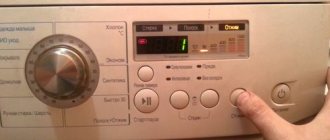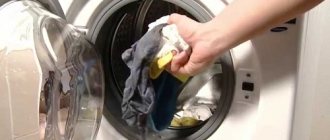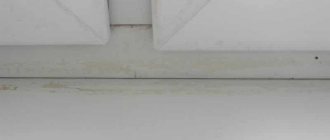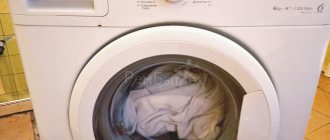You can find out why the washing machine stopped spinning clothes yourself. It is necessary to exclude the possibility of errors in the operation of equipment. Sometimes the reason for the lack of spinning is that the washing mode is set incorrectly. Delicate cleansing is often carried out without twisting; accordingly, when such a program is selected, the spin cycle does not start. If the problems did not appear due to non-compliance with the norms for using the machine, the reason should be sought in technical malfunctions. It is not recommended to remove them yourself. Incompetent intervention in the operation of the device can lead to serious damage; restoring the unit will be expensive.
“Simple” errors are eliminated without repair
Let's look at common faults that you can identify and fix yourself, without the help of professionals. These are problems that arise when equipment is used incorrectly.
Wrong choice of washing mode
The washing machine has washing programs where the spin mode is not provided. For example, “silk”, “delicate wash”, “wool”. After the end of the main process in these modes, the water is drained without spinning the laundry.
More detailed information about the cycles included in each program can be found in the operating instructions. The problem is easy to solve - you need to select the normal washing mode and adjust the number of revolutions.
Overload or uneven distribution of laundry in the drum
If you exceed the volume of items that each washing machine model is designed for, this will lead to disruption of operating modes. Drum overload is a common problem with top-loading machines.
The same difficulty can arise due to uneven distribution of laundry in the drum. During the washing process, things will clump together. At high speeds, an imbalance occurs in an overloaded drum, and the control module sends a signal to end the process without spinning.
Empty the machine of excess laundry and distribute the remaining items evenly.
Incorrect loading of the machine
Washing machines react negatively to both the large weight of clothing and its shortage. The automatic machine works in such a way that after activating the washing process, it “distributes” the load.
The drum rotates according to a specific beat, all loaded laundry is evenly spread over the cylinder, distributing the weight. At the same time, water is collected. When the mass of pawned clothing is very small, or it has gathered in a heap, a special sensor reacts. Therefore, the washing machine does not spin. These reasons trigger automatic protection of the machine, since at maximum speed the drum will experience an unacceptable level of load. But the same factor serves as the basis for turning off the machine when it is overloaded with clothes.
Main defects and solutions
There are many reasons why a washing machine does not spin clothes. If you have checked all the options, but the machine still does not go into spin mode, then start diagnosing the parts.
Drain pump malfunction
The drain pump (pump) is one of the main technical components. It maintains the required water level at all stages of washing and facilitates its drainage from the tank. It is located at the bottom of the unit under the tank. If the pump fails, the machine stops draining water, and as a result, the laundry does not spin.
Before you start disassembling the pump, you need to determine what has failed: the electrical or mechanical part.
The main reasons why the drain pump may fail.
- The coarse filter equipped with the drain pump is clogged.
It is located on the front body in one of the corners of the bottom. If you regularly wash woolen items without checking the pockets for small items, the filter can become clogged with debris and become very dirty. It must be checked constantly. There is usually a handle with which the filter can be unscrewed, removed and washed with water.
- The impeller is jammed; it is located immediately behind the filter.
During rotation, threads, wool, etc. may become wrapped around it. If you find debris blocking operation, then clean it.
You also need to check the rotation of the impeller; it should spin jerkily. If the blades move freely, the part must be secured more tightly.
- Problems with the drain hose.
We carefully check whether there are any blockages inside the hose, as well as its position - so that there are no kinks, remove it and rinse it under pressure of hot water.
If after cleaning and checking the problem is not resolved, then the drain pump requires repair. In this case (in the absence of special repair skills), it is better to seek the help of a specialist.
Failure of the pressure switch
The water level sensor (pressure switch) sends a signal to the controller about the presence or absence of water in the drum. Typically the sensor is located at the top of the side wall.
How to check the performance of the pressure switch.
- Turn off the power to the washing machine.
- Open the panel and unscrew the sensor, disconnect the pressure hose.
- Check the pressure pipes for blockages and flush if necessary.
- Conduct a visual inspection of the sensor (there should be no damage or formations).
- Inspect and, if dirty, clean the contacts.
- Install a silicone tube in place of the removed hose and blow strongly into it.
- If the sensor is working properly, then when the relay is activated, characteristic clicks will be heard.
If the pressure switch is faulty, it must be replaced. Installing a new sensor yourself is not difficult.
Electronic module problem
The most complex and expensive part of the mechanism is the electronic module; it is the one that monitors the operation of all processes and sensors. If it is faulty, it needs to be replaced or the entire system needs to be flashed.
Main reasons for failure:
- power surges;
- manufacturing defects;
- moisture ingress.
To diagnose the cause, it is better to give the control module to a specialist so that he can test the device.
Motor failure
The performance of the motor may be impaired due to inter-turn short circuit of the windings or wear of the graphite brushes. As a result, it will be able to rotate the drum only in washing mode (there will not be enough power for the maximum number of revolutions). The problem is solved by repair or replacement. A complete diagnosis can be carried out at a service center.
Faulty speed control sensor
The tachometer monitors the rotor speed of the electric motor, i.e. the number of drum revolutions per minute. Sensor malfunction is quite rare, mainly due to the coil being misaligned due to a loose screw.
It is necessary to check the wires, fastenings, contacts and fix the coil. If the problem is in the device itself, then it needs to be replaced.
Prevention
Regular maintenance helps reduce the risk of malfunction. For reliability, it is worth using a set of measures.
Checking pockets before washing
Foreign objects often become clogged in the filter, causing the spin function to turn off. Pre-checking your clothing pockets will eliminate the need to frequently clean the filter.
Washing powder quality
Poor quality powder negatively affects the condition of internal mechanisms. Using proven powders, you will be able to save on equipment repairs.
Network filters
Using a surge protector protects the washing machine from sudden power surges and short circuits. The surge protector turns on automatically and does not consume a large amount of resources.
Periodic cleaning of the machine
By periodically cleaning the filter and drum, you will be able to get rid of accumulated dirt in a timely manner. The ability to carry out cleaning yourself simplifies the maintenance of the machine.
Washing machine problems and solutions
What to do if the spin mode does not work
If the washing machine does not complete the last cycle, then you must:
- Check the washing mode selection. An explanation for each program is in the operating instructions.
- Avoid imbalance of laundry in the drum. Control the weight and distribution of things inside.
- Restart the program - a failure may have occurred.
- Conduct diagnostics of the main components.
The washing machine does not spin well
The main reason is that the water does not completely leave the tank, but the water level sensor does not send a signal about its presence. In such cases, it is necessary to inspect the drain pipe, hose and filter for blockages.
- Clean the drain filter and hose.
- Check that the drain hose is positioned correctly.
- If this does not help, remove the drain pipe between the pump and the drum and clean it of dirt.
Why doesn't the spin mode turn on?
If switching to spin mode does not occur in different washing options, the reasons may be:
- failure of the heating element;
- failure of the programmer and control module.
Spin mode does not turn off
A typical problem is when the machine does not turn off the program and does not stop washing.
- The water discharge valve is clogged and the speed control sensor is malfunctioning.
- Failure of the water heating element.
- The filter is clogged (the water circulation is disrupted and there is no signal to reset or complete the cycle).
- Incorrect operation of the electronic unit.
How to clean the drain filter
Cleaning the filter should be done in stages. The procedure requires the following steps:
- Turn off the water supply and disconnect the equipment from the power supply. This is necessary for safety reasons so as not to receive an electric shock.
- Open the hatch cover under which the filter is located. In some models, the filter is located under the false panel at the bottom of the case.
- Drain the remaining water from the tank. It is important to be prepared that water may start to pour out, so you should take a basin or a rag.
- Unscrew and remove the catch filter.
- Remove large debris and foreign objects from the filter. Having removed the main dirt, all that remains is to clean the filter with a regular sponge with a hard surface, and then rinse under high water pressure.
- Secure the filter to its original position. The part should be positioned evenly, without distortions.
Malfunctions requiring specialist assistance
There are some malfunctions that it is not recommended to fix on your own without special training and knowledge. There is a high probability of damage to other elements.
What to entrust to the service center masters:
- tachometer repair;
- diagnostics of pressure switch;
- engine repair;
- reflashing the control module or replacing the stabilizer.
In the video, the author explains how to solve the spin problem in an Indesit brand washing machine.
Spin does not turn off
Problems with the control module in the washing machine can result in the drum not stopping and the spin cycle not turning off. After such revolutions the car simply freezes. It may also be that the SMA squeezes, rinses, but does not wash. Or vice versa - it washes, but does not rinse.
All these signs indicate problems with the “brain” of SMA, so it begins to work incorrectly.
You can only visually inspect the control board yourself. It is better to entrust basic diagnostics and repairs to professionals.
- Unplug the washing machine.
- Remove the top cover.
- Pull out the dispenser tray. Pull it towards you, pressing the latch in the center.
- Remove the screws securing the control panel.
- Release the plastic latches and remove the panel.
- Release the wiring.
- To remove the board, also release the latches.
If no signs of damage are found on the surface of the board, contact the service center.
Preventive measures
By following the basic rules and operating recommendations, you can partially avoid damage to your washing machine.
- Periodically rinse the dispenser to remove any residual detergent.
- Do not overload the machine with laundry.
- Before washing, check all pockets and remove small parts that may clog the filter.
- Pour detergent strictly according to the norm; excess may accumulate in the dispenser and clog the grate.
- After each wash, wipe the rubber cuff of the hatch with a dry cloth.
- Maintain intervals between washes of 1-2 hours.
If you notice malfunctions and find a malfunction, immediately fix it. Remember: operating such a unit is prohibited and dangerous to life.
If the wash is finished, there are no errors on the display, but the laundry is wet
In this case there are several reasons:
- The speed is set to low (from 800 to 1000). Some device models cannot produce high-quality spins at low settings.
- Underweight. When washing one or more small items, spinning is difficult. It is recommended to fill the drum at least half of its required weight.
- Washing bulky laundry. When placing bedding in the bin, it often clumps or gets tangled during the spin cycle, so it remains damp.











